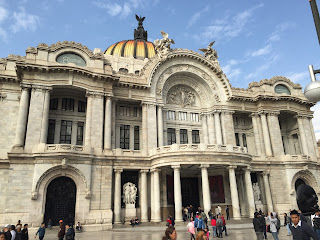At 9am, most people were heading into the city as we were heading out of it. So the trains were only completely full, not hanging-out-the-windows full.
We reached the bus terminal without much trouble, but I'll cut the chit chat. I want to get to the first majestic sight of the day.
We reached the bus terminal without much trouble, but I'll cut the chit chat. I want to get to the first majestic sight of the day.
Donuts!!!
Not only do we jump at any chance to continue our culinary tour of the world's donuts (nom, nom, nom), but this was the type of true panaderia that we had been searching for all week. Just look at that grin.
The panaderia was located right in the middle of the bus terminal, and we intentionally missed the first bus to the pyramids to make sure that had enough time to stock up. So with a lighter step and a heavier backpack, we set out on our adventure.
Like the Frida museum, it was not hard to find the bus to pyramids. We just walked towards all the white people.
The bus to the pyramids was like every other we had taken in the country: clean, cheap, and comfortable. But there were two notable exceptions. The first was that we were filmed about 20 minutes into the journey. After reaching the edge of town, a man in his 40s or 50s boarded the bus with a camcorder, and walked up and down the aisle, focusing on each of the passengers. If we hadn't been warned about that by fellow travelers, it would have been pretty weird. Well, actually, it was still pretty weird.
The filmer wasn't wearing any type of uniform and didn't make any kind of announcement. But knowing that Mexico City is trying to make intercity bus travel safer, I'm thinking that this was some sort of crime prevention strategy. And it worked. Nobody stole our donuts.
The second eccentricity about this particular bus was the entertainment. Most of our previous busses showed movies, and one even had an in-seat entertainment tablet. But this one had a traveling minstrel. After we were filmed, the driver made one other stop to pick up a man with a guitar case and a tattered suit. (No, not that guy.) And while he was no Antonio Banderas, he was actually a pretty good singer. He played us four or five songs, and collected his tips as we pulled into the pyramid grounds.
Even though the pyramids are only an hour away from Mexico City, the environment is dramatically different. It was hot, sandy, and dotted with cactus. If it weren't for the rolling hills, we could have been in Southern Arizona.
The pyramid grounds themselves span miles, and the bus drops tourists off at what is actually more of a side entrance. So there were only a couple of street vendors vying for our attention.
Even though the pyramids are only an hour away from Mexico City, the environment is dramatically different. It was hot, sandy, and dotted with cactus. If it weren't for the rolling hills, we could have been in Southern Arizona.
The pyramid grounds themselves span miles, and the bus drops tourists off at what is actually more of a side entrance. So there were only a couple of street vendors vying for our attention.
As you can see, the pyramids are spread out over a long stretch called the Avenue of the Dead. That's Aztec for Main Street.
Even though the pyramids were unearthed about a hundred years ago, new discoveries are being made all the time. It has the exciting feel of an active archeological site, and was a lot of fun to explore.
And of course we climbed up.
We explored the park for hours. It's unquestionably a world heritage landmark. Looking back, pictures don't really do it justice. You should just go check it out yourself.
Exhausted from the climbing and the sun, we napped on the bus back to Mexico City. But about halfway through the journey, our bus again stopped and picked up some more traveling singers. These guys were far younger than the first one, and something about their request for us to follow them on El Face (Facebook) cracked me up.
That evening, we wandered the streets near our hotel. We were half-looking for stamps to mail postcards, but we mostly just wanted to draw our vacation out a little longer. Central Mexico is such a unique and interesting part of the world, and we had such a nice time exploring it. We'll definitely miss this place. 23 million people can't be wrong.
-M
Even though the pyramids were unearthed about a hundred years ago, new discoveries are being made all the time. It has the exciting feel of an active archeological site, and was a lot of fun to explore.
And of course we climbed up.
We explored the park for hours. It's unquestionably a world heritage landmark. Looking back, pictures don't really do it justice. You should just go check it out yourself.
Exhausted from the climbing and the sun, we napped on the bus back to Mexico City. But about halfway through the journey, our bus again stopped and picked up some more traveling singers. These guys were far younger than the first one, and something about their request for us to follow them on El Face (Facebook) cracked me up.
That evening, we wandered the streets near our hotel. We were half-looking for stamps to mail postcards, but we mostly just wanted to draw our vacation out a little longer. Central Mexico is such a unique and interesting part of the world, and we had such a nice time exploring it. We'll definitely miss this place. 23 million people can't be wrong.
-M























































